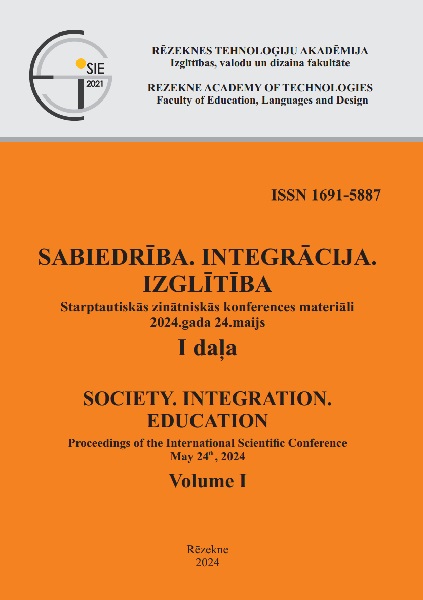ALCOHOL USE IN A GROUP OF ADOLESCENTS AS SOCIALLY DEFINED DEVIANT BEHAVIOR
DOI:
https://doi.org/10.17770/sie2024vol1.7816Keywords:
Adolescent, deviant behaviour, parents, social deviance, underage drinkingAbstract
Alcohol consumption among adolescents in social theories is considered a formally defined deviant behavior. There is no doubt about the negative health consequences of this behavior, however, several researchers point to its role in the process of growing up and socialization. Along with the development of theories of deviant behavior, the question – whether alcohol consumption among adolescents is still identified as deviant behavior, becomes relevant. To assess the aspect of alcohol consumption as a socially determined deviance, the results of a longitudinal cohort study among Latvian schoolchildren were analyzed. The analysis of the research data includes such indicators as the characteristics of the situation and age of the adolescent when they try to alcohol first and the attitude of parents towards adolescents alcohol use. The research data were compared in four stages from the start of 7th grade (T1) till the end of 9th grade (T4). The results indicate that adolescents are well informed about the legal ban on alcohol consumption (at the beginning of the study in the T1 period, 89.3% were aware of the ban on the use of alcohol by minors). Still, the contradictory behavior of the parents, allowing adolescents to consume alcohol (in the T4 period, 65.9% of students who have consumed alcohol, their parents have permitted to do so) creates an ambiguous perception of alcohol consumption as a deviant behavior among adolescents. In general, this contradiction can reduce the effectiveness of normative and communicative tools in the prevention of alcohol initiation among adolescents. The results of the study confirm - that to delay the initiation of alcohol consumption among adolescents - it is necessary to define alcohol consumption among adolescents as deviant behavior in society as a whole.
References
Comasco, E., Berglund, K., Oreland, L., & Nilsson, K.W. (2010). Why Do Adolescents Drink? Motivational Patterns Related to Alcohol Consumption and Alcohol-Related Problems. Substance Use & Misuse, 45, 1589 - 1604. DOI: https://doi.org/10.3109/10826081003690159
Douglas, J. D. & Waksler, F. (1982). The sociology of deviance: An introduction. Boston, MA: Little, Brown.
Garcia-Huidobro, D., Doty, J.L., Davis, L., Borowsky, I.W. & Allen, M.L. (2018). For Whom Do Parenting Interventions to Prevent Adolescent Substance Use Work? Prevention Science, Vol.19, pp. 570–578. DOI: https://link.springer.com/article/10.1007/s11121-017-0853-6
Gibbs, J. P. (1981). Norms, Deviance, and Social control: Conceptual matters. New York: Elsevier.
Heckert, A. & Heckert, D. M. (2002). A new typology of deviance: integrating normative and reactivist definitions of deviance, Deviant Behavior, 23:5, 449-479, DOI: https://doi.org/10.1080/016396202320265319
Jones, S. C. & Francis, K. L. (2015). Supply of alcohol to underage drinkers: Misperceptions of community norms. Social science & medicine, Vol.147, p.158-162, DOI: https://doi.org/10.1016/j.socscimed.2015.10.067
Kaynak, Ö., Winters, K.C., Cacciola, J., Kirby, K.C., & Arria, A.M. (2014). Providing alcohol for underage youth: what messages should we be sending parents? Journal of Studies on Alcohol Drugs. 75(4):590-605. https://doi.org/10.15288/jsad.2014.75.590
Kuo, P.C., Huang, J.H., Wu, S.C. & Chen, W.J. (2021). Associations of parental and peer cross-substance use with 12–17-year-old adolescents’ problematic alcohol use: A parent-child dyadic gender analysis. Drug and Alcohol Dependence, Vol. 221 (2021) 108611, DOI: https://doi.org/10.1016/j.drugalcdep.2021.108611
Levitt, A., & Cooper, M.L. (2015).Should Parents Allow Their Adolescent Children to Drink at Home? Family Factors as Predictors of Alcohol Involvement Trajectories Over 15 Years. Journal of Studies on Alcohol Drugs.76(5):661-70. DOI: https://doi.org/10.15288/jsad.2015.76.661
LR Saeima. (2004). Alkoholisko dzērienu aprites likums. 6. pans 2. punkts. Rīga: LR Saeima. Pieejams: https://likumi.lv/ta/id/88009-alkoholisko-dzerienu-aprites-likums
Lynch, S., Styles, B., Dawson, A., Worth, J., Kerr, D. & Lloyd, J. (2013). Talk About Alcohol: an Evaluation of the Alcohol Education Trust’s Intervention in Secondary Schools. Slough: NFER., 120 – 136.
Mahorney, M. & Faina, K.A. (2014). Drift theory. No (sast. Craig), Defining Deviance. Encyclopedia of Social Deviance vol.2 (223 -224). USA: Sage Publications.
Mārtinsone, K., Pipere, A. & Kamerāde, D. (2017). Pētniecība: teorija un prakse. Latvija: Raka.
SPKC. (2019). ESPAD 2019 Atkarību izraisošo vielu lietošanas paradumi un tendencies skolēnu vidū. ISBN 978-9934-514-63-0. Pieejams: https://www.spkc.gov.lv/sites/spkc/files/data_content/latvijas-skolenu-veselibas-paradumu-petijums-05.10.2020_1.pdf
Smith, A. & Pollack, H. (1976). Deviance as a Method of Coping. Crime & Delinquency, 22, 16 - 3. DOI: https://doi.org/10.1177/001112877602200102 Smith, M. A. (2021). Social Learning and Addiction. Behavioural Brain Research. 398 (2021) 112954. DOI: https://doi.org/10.1016/j.bbr.2020.112954
Staff, J. & Maggs, J. L. (2019). Parents Allowing Drinking Is Associated With Adolescents’ Heavy Alcohol Use. Alcoholism: clinical and experimental research. Vol 44, No 1, 2020: pp 188–195, DOI: https://onlinelibrary.wiley.com/doi/10.1111/acer.14224
Tittle, C. & Paternoster R. (2000). Social Deviance and Crime: an Organizational and Theoretical Approach. LosAngeles, CA: Roxbury.
Vanherle, R., Hendriks, H. & Beullens, K. (2023). Only for Friends, Definitely Not for Parents: Adolescents’ Sharing of Alcohol References on Social Media Features, Mass Communication and Society. Vol. 26, no. 1, 47–73. DOI: https://doi.org/10.1080/15205436.2022.2035767






